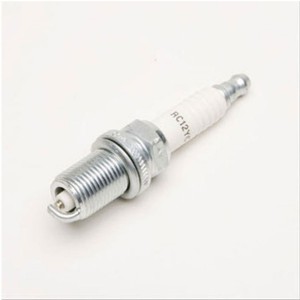 Your Cub Cadet’s spark plugs need to be checked and replaced regularly to keep the engine running at peak performance, and it can also help you diagnose problems.
Your Cub Cadet’s spark plugs need to be checked and replaced regularly to keep the engine running at peak performance, and it can also help you diagnose problems.
Spark Plug Characteristics
Gap: The spark jumps between the upper and lower parts of the electrode, igniting the fuel. This space needs to be the correct length to get proper ignition. As the electrode wears down, the gap will increase, requiring adjustment.
Heat range: The spark plug needs to stay hot enough to burn off deposits, but still cool enough to prevent melting. This temperature range is determined by the contact area between the plug and the head of the engine.
Removing the Spark Plug from Your Engine
Each cylinder needs a plug to ignite the fuel/air mixture inside, so single cylinder engines found in small equipment will have one plug, while the V-twins found in most riding mowers and commercial equipment will have two plugs. Since they screw into the head of the engine, they can get extremely hot; wait at least a half hour after running the motor before trying to remove a plug.
First, find the spark plug wire and trace it to the motor. Pull up on the spark plug cap at the end of this wire to disconnect it from the plug. Next, using a spark plug wrench or socket, unscrew the plug. The rubber sleeve inside the socket should keep the plug secure so that you can slide it out of the engine. Depending on the model, the plug may be 5/8, ¾ or 13/16 inch; Cub Cadet offers a single wrench designed to fit all three sizes.
Reading Spark Plugs
Once the plug is out, look at the electrodes on the end that was in the engine. Their appearance indicates how the engine is running:
If everything is working normally, the plug should be a light gray or brown.
Misfiring will leave a thin layer of ash are caused by misfiring. This is due to bad fuel or excess fuel or oil reaching the combustion chamber.
Wet, oily build up is the result of oil or excess gas in the combustion chamber. This is usually caused by carburetor problems resulting in a rich fuel mixture, worn out piston rings, valvetrain issues or a bad head gasket.
Dry, black soot is usually caused by a clogged air filter or carburetor. Using the wrong plug and ignition timing issues can also cause this build-up.
A broken insulator or a bent electrode is the result of contact between the plug and piston or sudden thermal expansion or shock. If the plug is the right size, it may be due to bad gas, a lean air/fuel mixture or timing issues.
If the spark plug wasn’t installed correctly, the plug can’t transfer heat to the engine, causing the electrode to melt. Using the wrong plug can also result in melting, as can an extremely lean air/fuel mixture.
If the insulator looks glazed and is coated in small black specs, the plug has overheated. This is the result of a lean air/fuel mixture, timing issues, poor cooling or the wrong plug.
Addressing Issues
Always use OEM plugs to ensure reliable performance and a good fit.
Ignition timing on small engines is controlled by magnets on the flywheel moving past the coil. If there are indications of timing being too advanced or retarded, the coil position may need to be adjusted and the flywheel checked for damage.
Air/fuel mixture issues are usually caused by a clogged air filter, clogged fuel system or perished seals around the carburetor.
The engine can overheat if the cooling fins are dirty or the air/fuel mixture is too lean.
Tipping the engine can let oil leak into the combustion chamber, as can worn piston rings.
Gapping the Plug
Using a feeler gauge, check the distance between the electrode and the ground against the specifications in your engine’s owner’s manual. Gently pry up on the electrode ground to expand the gap, and tap it to close the gap.
Reinstalling the Plug
Make sure the washer is on the end of the plug before installing.
Always start by hand tightening the plug to prevent cross-threading. Once the plug has bottomed out, use the plug socket or wrench to turn it until seated, plus a ¼ turn if the plug is used, or a ½ turn if the plug is new to get a good seal.
Get the Spark Plugs and Spare Parts You Need for Your Cub Cadet from Cub Parts
Cubparts.com is a certified dealer for Cub Cadet and their engine partners including Briggs & Stratton and Kawasaki, which means we have the OEM parts you need to keep your equipment running. Factory diagrams and descriptions are built into our search engine, making it easy to find what you need, and we can ship those parts to any address in the U.S. and Canada.
